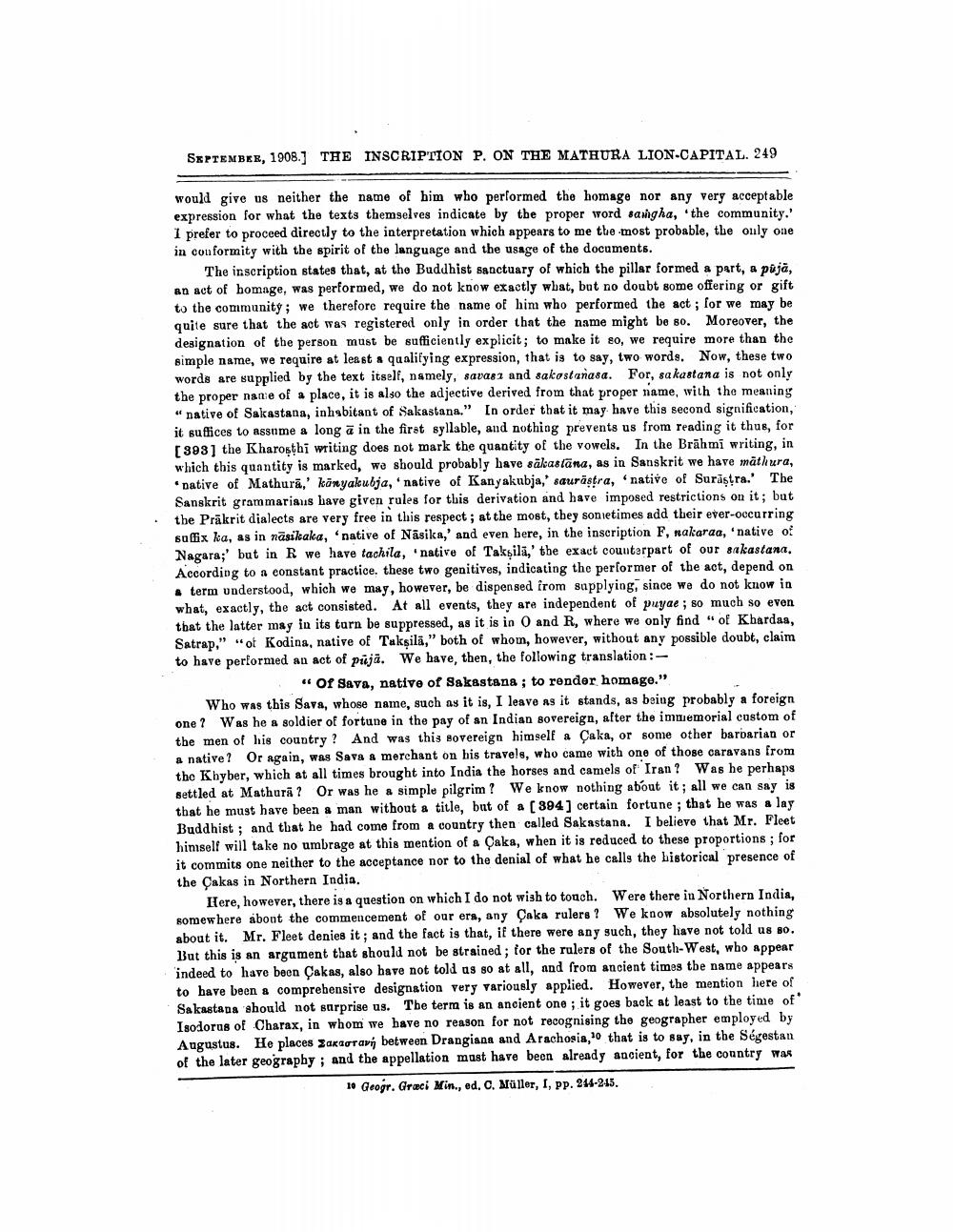________________
SEPTEMBER, 1908.] THE INSCRIPTION P. ON THE MATHURA LION-CAPITAL. 249
would give us neither the name of him who performed the homage nor any very acceptable expression for what the texts themselves indicate by the proper word sangha, 'the community.' I prefer to proceed directly to the interpretation which appears to me the most probable, the only one in conformity with the spirit of the language and the usage of the documents.
The inscription states that, at the Buddhist sanctuary of which the piller formed a part, a puja, en act of homage, was performed, we do not know exactly what, but no doubt some offering or gift to the community; we therefore require the name of him who performed the act ; for we may be quite sure that the act was registered only in order that the name might be 80. Moreover, the designation of the person must be sufficiently explicit; to make it so, we require more than the simple name, we require at least a qualifying expression, that is to say, two words. Now, these two words are supplied by the text itself, namely, savas1 and sakostanasa. For, sakastana is not only the proper name of a place, it is also the adjective derived from that proper name, with the meaning "native of Sakastana, inhabitant of Sakastana." In order that it may have this second signification, it suffices to assume a long ā in the first syllable, and nothing prevents us from reading it thus, for [393) the Kharosthi writing does not mark the quantity of the vowels. In the Brāhmi writing, in which this quantity is marked, we should probably have sākastāna, as in Sanskrit we have mathura,
native of Mathurā,' kanyakubja, 'native of Kanyakubja,' saurāstra, native of Surāştra.' The Sanskrit grammarians have given rules for this derivation and have imposed restrictions on it; but the Prākrit dialects are very free in this respect; at the most, they sonetimes add their ever-occurring sofix ka, as in nāsikaka, native of Näsika,' and even here, in the inscription F, nakaraa, 'native of Nagara;' but in Rwe have tachila, native of Taksilā,' the exact counterpart of our sakastana, According to a constant practice. these two genitives, indicating the performer of the act, depend on • term understood, which we may, however, be dispensed from supplying, since we do not know in what, exactly, the act consisted. At all events, they are independent of puyae ; so much so even that the latter may in its torn be suppressed, as it is in 0 and R, where we only find" of Khardas, Satrap," "ot Kodina, native of Taksilā," both of whom, however, without any possible doubt, claim to have performed an act of puja. We have, then, the following translation:
" Or Sava, native of Sakastana; to render homage." Who was this Sava, whose name, such as it is, I leave as it stands, as being probably a foreign one? Was he a soldier of fortune in the pay of an Indian sovereign, after the immemorial custom of the men of his country? And was this sovereign himself a Çaka, or some other barbarian or a native? Or again, was Sava a merchant on his travels, who came with one of those caravans from the Khyber, which at all times brought into India the horses and camels of Iran? Was he perhaps settled at Mathura ? Or was he a simple pilgrim? We know nothing about it; all we can say is that he must have been a man without a title, but of a (394) certain fortune ; that he was a lay Buddhist ; and that he had come from a country then called Sakastana. I believe that Mr. Fleet himself will take no umbrage at this mention of a Caka, when it is reduced to these proportions ; for it commits one neither to the acceptance nor to the denial of what he calls the historical presence of the Çakas in Northern India.
Here, however, there is a question on which I do not wish to touch. Were there in Northern India, somewhere abont the commencement of our ers, any Çaka rulers? We know absolutely nothing about it. Mr. Fleet denies it; and the fact is that, if there were any such, they have not told us so. But this is an argument that should not be strained; for the rulers of the South-West, who appear indeed to have been Cakas, also have not told us so at all, and from ancient times the name appears to have been a comprehensive designation very variously applied. However, the mention here of Sakastana should not surprise us. The term is an ancient one ; it goes back at least to the time of Isodorus of Charax, in whom we have no reason for not recognising the geographer employed by Augustus. He places Sakaorary between Drangiana and Arachosis, that is to say, in the Ségestan of the later geography; and the appellation must have been already ancient, for the country was
10 Geogr. Græci Min., ed. C. Müller, I, pp. 244-245.




